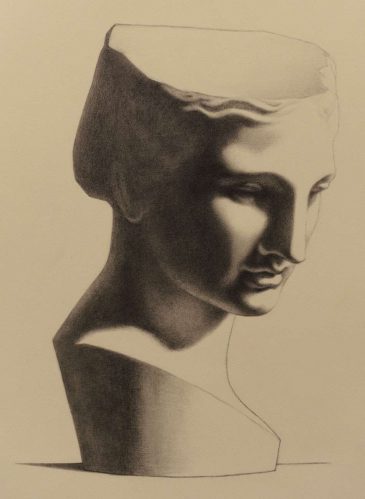
Camels casting shadows on the sand
Who doesn’t remember that moment of seeing their own shadow? Maybe it was having Peter Pan read to us that nudged us into seeing it ‘attached’ to our feet and following our every move. And those early recollections of being in the warm bright sunshine – all happiness and light – then moving into a dark and different place just by walking under a tree’s canopy or around the corner into the shady side of a house?
As painters, light in all its forms is our greatest ally. The different grades of light or dark are known as their Value. The darkness or lightness of anything at all is one of the most important elements to be mastered if we want to give a sense of things looking real. Without light we would not see anything, of course. Without a mastery of handling the darkness or lightness things won’t appear to be ‘real’.

A painting in progress, head and hair casting shadow on neck and shoulders
DIFFERENT TYPES OF SHADOW
There are just two kinds of shadows and from a Realist Painter’s perspective each are equally important. Let me introduce you to one of them.
THE CAST SHADOW
This shadow is quite literally cast upon an object, surface, limb, feature . . . that we are looking at and that is to be painted. The reason why it is cast? Because there is something between the light source interrupting the light going any further.
On a sunny day, a tree’s leaves, branches and trunk will cast a shadow on the ground. The tree is getting in between the sun’s rays stopping those rays falling on the ground.
Walking on a garden path leading around the corner of a house, we are walking into the shady side where the house is interrupting the sunlight falling onto the path.
Whatever it is that is getting between the source of light and the ground, is absorbing (and bouncing) the light, preventing it going any further.

Bargue Lithograph of Psyche of Naples – graphite drawing.
I find shadows very fascinating. Let’s continue – this shadow which falls upon the ground describes itself. It describes which parts of it are near the ground and which are further away. Back to the tree trunk – where it comes out of the ground the shadow shape will be crisp and sharp. The branches and leaves will make shapes that become more and more blurred the further away they are. What this means for me and my flat canvas is that I will use clearly defined brush strokes for the sharp edges to the shadow, becoming more softly blended as the shadow changes.
The shadow itself is not just an approximate indiscernible shape but very specifically charts the overall shape of the tree.
These things are the very stuff of life to a Realist Painter. So much so that I have begun writing a Blog where I shall be going into them more deeply along with other highs and lows of studio life. Please do go and have a look and subscribe to www.blog.marilynbailey.com where there will be a growing personal encyclopedia of events and images that compose the Studio Life of an Artist. It is a great joy to have this opportunity to share some aspects of my passion and vocation for Painting with you.
Marilyn Bailey’s paintings were recently hung by West Sussex based Antique Dealers Wakelin & Linfield in the highly prestigious BADA Fair (British Antiques Dealers Association) in Duke of York Square, Kings Road, London. ![]()
References:
www.BADA.org
www.wakelin-linfield.com
www.blog.marilynbailey.com











